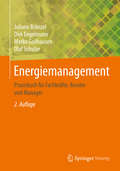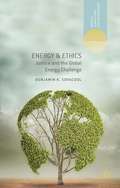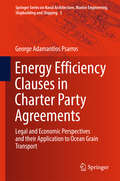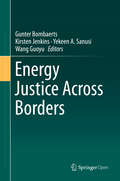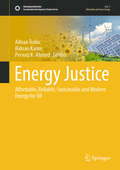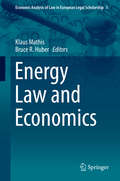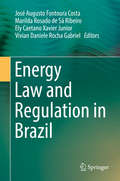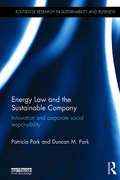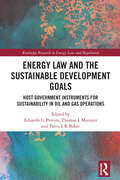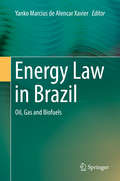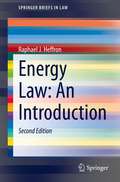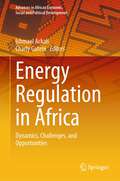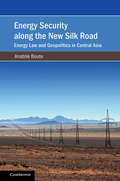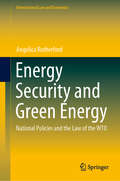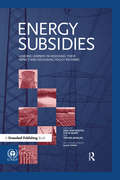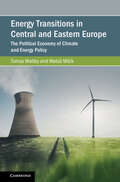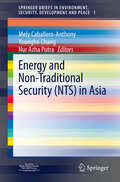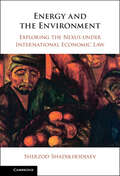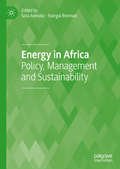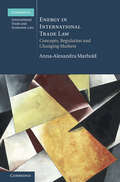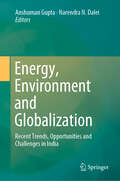- Table View
- List View
Energiemanagement: Praxisbuch für Fachkräfte, Berater und Manager
by Marko Geilhausen Juliane Bränzel Dirk Engelmann Olaf SchulzeDas Buch stellt die Anforderungen der ISO 50001 als Grundlage für eine Zertifizierung dar. Dabei wird immer die Sicht des Energiemanagementbeauftragten im Auge behalten, indem praktische Hinweise für die Umsetzung und zu den einzelnen Normenpunkten gegeben werden. Die Änderungen zur Vorgängernorm DIN EN 16001 sind dargestellt und Möglichkeiten der Integration eines Energiemanagementsystems in bestehende Systeme nach ISO 9001 und ISO 14001 werden beschrieben. Damit bietet das Buch sowohl Neueinsteigern als auch Routiniers eine wertvolle Hilfe, die in Form dieses Enchiridions zur Verfügung steht.
Energiemarkt Deutschland: Daten und Fakten zu konventionellen und erneuerbaren Energien
by Hans-Wilhelm SchifferEnergiewirtschaftliche Entscheidungen und technische Weichenstellungen erfordern eine fundierte Datenbasis. Die wichtigsten Zahlen und Fakten zu deutschen und europäischen Energiemärkten (Mineralöl, Braunkohle, Steinkohle, Erdgas und Elektrizität), zu den Eigentumsverhältnisse von über 100 Energieunternehmen und Nachfrage- sowie Angebotsstrukturen sind in diesem Buch vermittelt. Es bietet sich als Nachschlagewerk und Einführung in die vielfältige Thematik an. Über 100 Tabellen und mehr als 200 Diagramme erleichtern den Zugang zu den umfangreichen Daten. Ein Glossar hilft dabei, Klarheit in die unterschiedlichen Begrifflichkeiten zu bekommen. Berater, Entscheider und an Kennzahlen interessierte Leser finden in diesem Buch umfangreiches Material für die eigene fachliche Fragestellung. Der Autor ist Executive Chair of the World Energy Resources Programme des World Energy Council, London. Er war viele Jahre in zwei Bundesministerien sowie in leitender Funktion bei einem großen Energieunternehmen tätig und ist Lehrbeauftragter in verschiedenen Masterstudiengängen an der RWTH Aachen.Aus dem Inhalt- Grundlagen der Energiewirtschaft- Struktur einzelner Energie-Teilmärkte- Erneuerbare Energien- Preisbildung in der Energiewirtschaft- Entwicklung der Energienachfrage- Klimaschutz und Emissionshandel- Perspektiven der Energieversorgung- Energiepolitik (Bundesebene)
Energy & Ethics
by Benjamin K. SovacoolBenjamin K. Sovacool applies concepts from justice and ethics theory to contemporary energy problems, and illustrates particular solutions to those problems with examples and case studies from around the world.
Energy Efficiency Clauses in Charter Party Agreements
by George Adamantios PsarrosThis book provides practical solutions for addressing energy efficiency as a clause term within a charter party contract. For this, upon a reflection of the regulatory craft, it analyzes key concepts of case law, and discusses them together with commercial and economic principles. In this way, the book aims at offering a comprehensive, interdisciplinary view of the chartering process, together with a new approach for safeguarding energy efficiency investments. A special emphasis is given to the maritime industry. Here, the newly developed framework, based on game theory, has been successfully applied to demonstrate the importance of including a clause term in contract negotiation to achieve protection against both an uncertain market and an even more challenging shipping environment. The book not only fills a gap in the literature, covering a topic that has been largely neglected to date, yet it offers researchers and practitioners extensive information to change the chartering process radically.
Energy Follies: Missteps, Fiascos, and Successes of America's Energy Policy
by Robert R. Nordhaus Sam KalenConversations about energy law and policy are paramount, undergoing new scrutiny and characterizations. Energy Follies: Missteps, Fiascos, and Successes of America's Energy Policy explores how a century of energy policies, rather than solving our energy problems, often made them worse; how Congress and other federal agencies grappled with remedying seemingly myopic past decisions. Sam Kalen and Robert R. Nordhaus investigate how misguided or naïve energy policy decisions caused or contributed to past energy crises, and how it took years to unwind their effects. This work recounts the decades-long struggles to move to market supply and pricing policies for oil and natural gas in order to make competition work in the electric power industry and to tame emissions from the coal fleet left to us by the 1970s coal policies. These historic policies continue to present struggles, and this book reflects on how future challenges ought to learn from our past mistakes.
Energy Justice Across Borders
by Gunter Bombaerts Kirsten Jenkins Yekeen A. Sanusi Wang GuoyuThis book is open access under a CC BY 4.0 license.We must find new and innovative ways of conceptualizing transboundary energy issues, of embedding concerns of ethics or justice into energy policy, and of operationalizing response to them. This book stems from the emergent gap; the need for comparative approaches to energy justice, and for those that consider ethical traditions that go beyond the classical Western approach. This edited volume unites the fields of energy justice and comparative philosophy to provide an overarching global perspective and approach to applying energy ethics. We contribute to this purpose in four sections: setting the scene, practice, applying theory to practice, and theoretical approaches. Through the chapters featured in the volume, we position the book as one that contributes to energy justice scholarship across borders of nations, borders of ways of thinking and borders of disciplines. The outcome will be of interest to undergraduate and graduate students studying energy justice, ethics and environment, as well as energy scholars, policy makers, and energy analysts.
Energy Justice: Affordable, Reliable, Sustainable and Modern Energy for All (Sustainable Development Goals Series)
by Adnan Trakic Pervaiz K. Ahmed Ridoan KarimThis book delves into the pressing issue of energy justice as it relates to SDG 7 and its far-reaching implications for society. With a comprehensive exploration of various aspects, from reducing energy burdens to political considerations, environmental justice, and human rights, this thought-provoking collection of chapters offers a profound understanding of the challenges and potential solutions surrounding energy justice. Starting with an introduction to the concept of energy justice and its significance, the editors lay the groundwork for an engaging discourse. The book then delves into the disproportionate energy burdens faced by low-income communities, shedding light on the difficult choices they must make to meet their basic needs. It further examines the intricate interplay between energy justice, politics, and environmental concerns, striving to find a harmonious balance. Drawing from a diverse range of perspectives, the chapters explore the intersection of energy justice with human rights, analyzing its implications for countries worldwide. The book also investigates the influence of disruptive events on renewable energy programs, presents an Islamic perspective on energy justice, and highlights the roles of the financial sector, fossil fuel industry, nuclear energy sector, and energy technology innovation in mitigating energy injustice. Chapter 'The Role of the Financial Sector in Energy Justice' is available open access under a Creative Commons Attribution 4.0 International License via link.springer.com.
Energy Law and Economics (Economic Analysis of Law in European Legal Scholarship #5)
by Klaus Mathis Bruce R. HuberThis book offers an edited volume for all readers who wish to gain an in-depth grasp of the economic analysis of recent developments in energy law and policy in Europe and the United States. In response to waning resources and heightened environmental awareness, many countries are now seeking to redefine their energy mix. Several energy sources are available: coal and oil, natural gas, and a variety of renewables. Yet which of them are capable of addressing core energy-related concerns? Reliability, security, affordability, fairness, and sustainability all have to be taken into account. Further, once a target mix has been identified, two challenges remain for legal scholars: what role does the law play in achieving a specified energy mix, and, how can the law best fulfill that role? The essential energy concerns are just as important in defining the way we shape our energy mix as they are in defining the mix itself.An example of current challenges in energy law and policy can be seen in the pursuit by the German and Swiss governments of the so-called “Energiewende” (energy transition). These policies are intended to enable the transition from a non-sustainable use of fossil and nuclear energy to a more sustainable approach based on renewable energies. On the one hand, the goal is to achieve a decarbonization of the energy economy by reducing the use of fossil energy sources such as petroleum, carbon and natural gas. On the other, and in response to the Fukushima nuclear accident, a phase out is intended to eliminate the dangers of nuclear technologies. Achieving these goals poses tremendous challenges for the two countries’ energy policies – partly because the energy transition will not only affect energy production, but also energy consumption.From a Law and Economics perspective, a number of questions arise: to what extent is it justifiable to rely on markets and continued technological innovation, especially with regard to the present exploitation of scarce resources? To what extent is it necessary for states to intervene in energy markets? Regulatory instruments are available to create and maintain more sustainable societies: command and control regulations, restraints, Pigovian taxes, emission certificates, nudging policies, and more. If regulation in a certain legal field is necessary, which policies and methods will most effectively spur the sustainable consumption and production of energy in order to protect the environment while mitigating any potential negative impacts on economic development? Do neoclassical and behavioural economics provide us with a suitable framework for predicting the market’s complex reactions to a changing energy policy? This book provides theoretical insights as well as empirical findings in order to answer these vital questions.
Energy Law and Regulation in Brazil
by José Augusto Fontoura Costa Marilda Rosado de Sá Ribeiro Ely Caetano Xavier Junior Vivian Daniele Rocha GabrielThe book presents contributions from Brazilian experts on the regulation of different energy sources. Focusing on describing and discussing the fundamental issues related to the legal regulation of each of the sources that compose Brazil's energy matrix, it also analyzes economic and strategic aspects and identifies the main current problems related to the exploration for and production of each energy source. The book offers a clear and detailed overview of energy law and regulation for policymakers, foreign investors and legal professionals dealing with energy projects in Brazil.
Energy Law and the Sustainable Company: Innovation and corporate social responsibility (Routledge Research in Sustainability and Business)
by Patricia Park Duncan Magnus ParkWhat kind of decision-making should multinationals engage in to create a sustainable company? There is substantial debate over why CEOs, senior management and Boards of Directors make the wrong decisions by not asking the right questions, with the result that not only is the company itself damaged, but all of the stakeholders find themselves at a detriment. Focusing on innovation, technology transfer and the use of intangible assets, Energy Law and the Sustainable Company features case studies from the oil and gas sector, to illustrate how to develop a sustainable business. Considering corporate social responsibility from the perspective of international and national law, the book demonstrates how companies can be both profitable and ethical using the influences of psychology to encourage senior decision makers to make the right decisions. It was revealed that reputation was the main principle influencing decision-making. The book also discusses how companies have reported on their sustainability strategy and considers how technology transfer and intangible assets may play a part in addressing global sustainability. This book should be invaluable reading to students and scholars of Sustainable Business, Business Law, Corporate Social Responsibility, Environmental and Energy Law as well as Environmental and Energy Management.
Energy Law and the Sustainable Development Goals: Host Government Instruments for Sustainability in Oil and Gas Operations (Routledge Research in Energy Law and Regulation)
by Thomas L Muinzer Eduardo G Pereira Patrick R BakerThe UN Sustainable Development Goals are an ambitious agenda for environmental sustainability, economic development, and social transformation. The SDGs include targets for governments, in partnership with private industry and communities, to improve access to affordable and reliable energy, reduce inequality, protect natural resources, and invest in transparent legal institutions and resilient infrastructure. Although transitioning energy systems towards a low-carbon future is a core aspect of the SDGs, the International Energy Agency anticipates that oil and gas will remain a significant component of the global energy mix for some time. Host Government Instruments are tools which governments use to grant oil and gas companies permission to develop state-owned resources. In addition to bringing substantial resources into governments, these HGIs often also include environmental commitments as well as commitments to local hiring, stakeholder engagement, and investment in economic development programmes. The different structures of HGIs and their precise terms and conditions are crucial determinants of the sustainability of oil and gas operations conducted thereunder. This book addresses how governments can use HGIs to advance the SDGs. Part I introduces the SDGs and the legal institutions and governance related to HGIs, including in relation to international energy development, international environmental treaties, the Paris Agreement, and human rights regimes. Part II examines specific provisions within HGIs and regulatory systems which relate to the oil and gas sector and SDGs. It provides case studies to illustrate approaches to HGIs and to identify opportunities for host governments and international oil and gas companies to advance the SDGs. The book concludes with a summary of recommendations regarding how host governments, in partnership with the oil and gas industry, can use HGIs to advance economic development and sustainability goals, and advances potential insights towards development of new and renewable resources.
Energy Law in Brazil
by Yanko Marcius de Alencar XavierThis book describes the energy-law situation in Brazil. It focuses on three specific energy sectors: oil, natural gas and biofuel. The decision to concentrate on these areas takes into account the role that these energy sectors play in the economic, political and legal systems in Brazil, as well as the fact that they are the primary subjects of current discussions surrounding economic regulation in the country. The book, composed of thematic chapters authored by specialized legal researchers, analyzes the different aspects of the oil, gas and biofuels industry, starting with an introduction and technical points and followed by a discussion of the legal issues. It also considers the different legal areas used to examine the aforementioned energy sectors, such as regulatory law, environmental law, tax law, international law, among others. The book will serve as a valuable guide for researchers interested in understanding Brazilian energy law, and at the same it time presents the state of the art of studies carried out in Brazil.
Energy Law: An Introduction (SpringerBriefs in Law)
by Raphael J. HeffronThe aim of this short text is simply to introduce a reader to this topic. It is intended for a global audience and rather than being restricted to potential energy law students of a particular country. It is also written for students of other disciplines such as geographers, social scientists and engineers. It should also be engaging to those in a variety of professional practices who want an accessible background to and overview of the subject.The first edition of Energy Law: An Introduction was a great success and this extended second edition is expected to be just as successful. It is used widely as a core text in energy law courses across the world and this second issue adds further discussion on important topics such as energy law principles and drivers. Further, it highlights issues of energy justice, a growing and an emergent topic which is also at the core of the energy law principles and the key drivers of why new energy law is formulated.The text aims to outline the principles and central logic behind energy law. Therefore, readers from across the world should be able to use it as a guide to thinking about energy law in their own countries. A variety of examples from many different countries are included in the text and while examples and comparisons are mainly from the EU and US, they represent good examples of more advanced and innovative energy law.For those readers who seek further or more in-depth knowledge, this text will only serve as an introduction. However, a key focus of the book is to direct the reader where they to look for further information and within the book there are suggested extra readings, the key recommended journals to read and other sources of information based on institutions who publish further material in this area. Overall this second edition of Energy Law: An Introduction aims to inspire students and others to contribute to try and improve energy law across the world and enable us all to contribute in our own small way to delivering a just and sustainable energy world for future generations.
Energy Policy Advancement: Climate Change Mitigation and International Environmental Justice
by Martha J. Crawford Elena V. Shabliy Dmitry KurochkinThis book states that sustainable development has become an influential discourse worldwide. Climate change is not only an urgent problem, but it is also a fundamental spiritual question concerning social justice and sustainable peace development as well as solidarity among people of various religious backgrounds and different countries. Thus, this global problem must be faced and recognized for future actions and strategies. However, the politics of fear must be replaced with a culture of peace, hope, and compassion, and this urgent problem must be faced with an optimistic attitude and a certain degree of preparedness.Climate change is evident in many forms, such as, for example, the most obvious—recent weather fluctuations that happen around the world. Floods, droughts, and hurricanes are those visible signs of climate change. Human-caused climate change is projected to greatly impact marine, freshwater, and terrestrial life. Temperatures in Alaska and the Arctic have increased over the last 50 years at a rate more than twice as fast as the global average temperature. Poor people are vulnerable to man-made climate change and respond rapidly to its impacts.Diverse knowledge of and approaches to climate change help understand this growing problem; global average air temperature has increased in the recent past by approximately 1.0°C (1.8°F). According to the Climate Science Special Report, the last several years have been record-breaking, and the period of 1901–2016 is the warmest. Greenhouse gas (GHG) emissions are still rising, with damaging effects on the Earth’s climate. At the moment, the concentration of CO2 is higher than at any point in time—at least the past 800,000 years. However, carbon dioxide (CO2) is not the only GHG that impacts human-induced climate change.
Energy Regulation in Africa: Dynamics, Challenges, and Opportunities (Advances in African Economic, Social and Political Development)
by Ishmael Ackah Charly GateteThis book analyzes the political economy governing energy regulation across the African continent. Presenting case studies that span diverse energy sectors and countries, it provides an overview of their complex political and regulatory frameworks. The book explores emerging technologies and energy markets, highlighting Africa’s preparedness for the energy transition, and sheds light on the pivotal role of cross-border energy trade with regard to energy access. Further, it examines regulators’ influence within regional power pools, as well as their contribution to gender mainstreaming in the energy sector, addressing vital social issues. This book is divided into five parts, the first of which focuses on the political economy of energy regulation. The second part discusses emerging technologies and climate change issues, while the third examines regional energy markets, and regional institutional collaboration. The fourth part features contributions on gender mainstreaming, while part five rounds up the coverage. The book will be of interest to policymakers and investors in Africa, as well as scholars interested in energy regulation and economics.
Energy Security along the New Silk Road: Energy Law and Geopolitics in Central Asia (Cambridge Studies on Environment, Energy and Natural Resources Governance)
by Anatole BouteGuaranteeing energy security is one of the most complex challenges of energy law and policy. Energy insecurity threatens economic development, social peace and stability. This book focuses on energy security in the strategically important region of Central Asia. The region holds huge energy reserves, but its energy systems are highly inefficient and unreliable, and thus require urgent reform. However, endemic corruption, discrimination and the strong centralization of power have so far blocked initiatives to reorganize energy supply. The case of Central Asia is uniquely relevant for understanding the informal constraints on energy law and policy. In addition, Central Asian energy insecurity illustrates the impact of geopolitics on the regulation of energy markets. The region is strategically located in Russia's sphere of influence and along China's New Silk Road. Its energy situation highlights the complex interactions amongst energy law, geopolitics and institutions.
Energy Security and Green Energy: National Policies and the Law of the WTO (International Law and Economics)
by Angelica RutherfordThis book shows how the links between energy security and national and international law and policies on green energy pose challenges to a transition towards a green energy system. Based on empirical work carried out in two very different country case studies – Great Britain and Brazil – this book attempts to foster a better understanding of the role played by energy security in constructing and deconstructing green energy policy initiatives. The broad range of views raised in national contexts leads to legal disputes in international forums when attempts are made to address the issues of this energy security/green energy interplay. As such, building on the findings of the case studies, this book then analyses the interplay between energy security and green energy development in international trade law as encapsulated in the law of the World Trade Organisation (WTO). Finally, the author proposes a way forward in creating the legal space in the law of the WTO for trade restrictive measures aimed at ensuring green energy security.
Energy Security, Equality and Justice
by Benjamin K. Sovacool Roman V. Sidortsov Benjamin R. JonesThis book applies concepts from ethics, justice, and political philosophy to five sets of contemporary energy problems cutting across time, economics, politics, geography, and technology. In doing so, the authors derive two key energy justice principles from modern theories of distributive justice, procedural justice, and cosmopolitan justice. The prohibitive principle states that "energy systems must be designed and constructed in such a way that they do not unduly interfere with the ability of people to acquire those basic goods to which they are justly entitled." The affirmative principle states that "if any of the basic goods to which people are justly entitled can only be secured by means of energy services, then in that case there is also a derivative entitlement to the energy services." In laying out and employing these principles, the book details a long list of current energy injustices ranging from human rights abuses and energy-related civil conflict to energy poverty and pervasive and growing negative externalities. The book illustrates the significance of energy justice by combining the most up-to-date data on global energy security and climate change, including case studies and examples from the electricity supply, transport, and heating and cooking sectors, with appraisals based on centuries of thought about the meaning of justice in social decisions.
Energy Subsidies: Lessons Learned in Assessing their Impact and Designing Policy Reforms
by Anja Von Moltke Klaus Töpfer Colin McKee Trevor MorganThe need to reform energy subsidies was one of the pressing issues highlighted at the World Summit on Sustainable Development. Many types of subsidy, especially those that encourage the production and use of fossil fuel, and other non-renewable forms of energy, are harmful to the environment. They can also have high financial and economic costs, and often only bring few benefits to the people for whom they are intended.Removing, reducing or restructuring such energy subsidies is helpful for the environment and the economy at the same time. Potential social costs in terms of employment in the conventional energy industry or reduced access to energy could be addressed by redirecting the money formerly spent on subsidies to income support, health, environment, education or regional development programmes.Of course, subsidies can have certain positive consequences, particularly where they are aimed at encouraging more sustainable energy production and use. Temporary support for renewable energy and energy-efficient technologies to overcome market barriers, and measures to improve poor or rural households' access to modern, commercial forms of energy, for instance, could be positive measures in support of sustainable development.Based on ground-breaking work undertaken by UNEP and the International Energy Agency, this book aims to raise awareness of the actual and potential impacts of energy subsidies and provide guidance to policy-makers on how to design and implement energy-subsidy reforms. It provides methodologies for analysing the impact of subsidies and their reform, and reviews experiences with energy subsidies in a number of countries and regions. Drawing on these case studies, it analyses the lessons learned as well as the policy implications, and provides guidance on how to overcome resistance to reform.The book provides an analytical framework which aims to set the scene for the detailed discussion of energy-subsidy issues at the country level. It considers how subsidies are defined, how they can be measured, how big they are and how their effects can be assessed. A more detailed discussion of methodological approaches to the assessment of the economic, environmental and social effects of subsidies and their reform is contained in the Annex.Chapters 3–11 of the book contain country case studies from contributing authors, which review various experiences and issues related to energy subsidies in selected countries, but do not strive for a common approach. They are organised along geographical lines, beginning with a review of energy subsidies generally in OECD countries. Case studies of energy subsidies in transition economies – the Czech and Slovak Republics (Chapter 4) and Russia (Chapter 5) – follow. Three studies of Asian countries focus on the costs of different types of energy subsidy: electricity subsidies in India (Chapter 6), oil subsidies in Indonesia (Chapter 7) and energy subsidies generally in Korea (Chapter 8). Chapter 9 reviews the effect of energy subsidies in Iran and suggests a pragmatic approach to reforming them. This is followed by an assessment of the LPG subsidy programme in Senegal (Chapter 10) and an analysis of the effects of removing coal and oil subsides in Chile (Chapter 11).Chapter 12 analyses the lessons learned from these case studies, focusing on the economic, environmental and social effects and their implications for policy. Finally, Chapter 13 discusses the implications of these findings and makes practical recommendations for designing and implementing policy reforms.This book will be essential for both practitioners and academics involved in the energy sector and for governments and policy-makers wishing to examine the reform of energy subsidies.
Energy Transitions in Central and Eastern Europe: The Political Economy of Climate and Energy Policy (Cambridge Studies on Environment, Energy and Natural Resources Governance)
by Tomas Maltby Matúš MišíkThis book examines the mutual interplay of climate and energy policies in eleven Central and Eastern European countries in the context of the EU's energy transition. Energy security has long been prioritised in the region and has shaped not only national climate and energy policy, but also EU-level policy-making and implementation. Whilst the region shares economic, institutional and historical energy supplier commonalities it is not homogenous, and the book considers the significant differences between the preferences and policies of these member states. Chapters also explore the effect of the EU on member states that have joined since 2004 and their influence on the EU's energy and climate policies and their role in highlighting the importance of the concepts of security and solidarity. The book highlights the challenges to, and drivers of, energy transitions in the region and compares these with those in global energy transitions.
Energy and Non-Traditional Security (NTS) in Asia
by Mely Caballero-Anthony Youngho Chang Nur Azha PutraTraditional notions of security are premised on the primacy of state security. In relation to energy security, traditional policy thinking has focused on ensuring supply without much emphasis on socioeconomic and environmental impacts. Non-traditional security (NTS) scholars argue that threats to human security have become increasingly prominent since the end of the Cold War, and that it is thus critical to adopt a holistic and multidisciplinary approach in addressing rising energy needs. This volume represents the perspectives of scholars from across Asia, looking at diverse aspects of energy security through a non-traditional security lens. The issues covered include environmental and socioeconomic impacts, the role of the market, the role of civil society, energy sustainability and policy trends in the ASEAN region.
Energy and the Environment: Exploring the Nexus under International Economic Law
by Sherzod ShadikhodjaevEnergy intersects with the environment at all stages of its life cycle by affecting nature and public health and is subject to government measures concerning low-carbon growth, energy efficiency and conservation, renewable energy and ecologically safe supply of nuclear and other energy resources. This timely book provides a comprehensive analysis of the role of international economic law in regulating such an energy-environment nexus under the regimes of the WTO, the Energy Charter Treaty, regional trade agreements and investment treaties. The author discusses the international environmental and economic law foundations of this nexus and extensively examines relevant rules, jurisprudence and practices regarding trade restrictions, subsidies, technical standards, investment protection and technology policies. This book highlights the existing gaps and 'greening' solutions within the framework of international economic law. Where relevant, it draws comparisons between trade law and investment law to show their similarities, differences and (potential) conflicts at the energy-environment interface.
Energy in Africa: Policy, Management and Sustainability
by Sola Adesola Feargal BrennanBringing together conceptual, theoretical and evidence-based contributions from a diverse set of experts, this book provides a comprehensive analysis of energy in Africa, from a management perspective. Taking a closer look at the global energy environment and security in developing areas of the region, the authors discuss the significance of energy policy to the socio-economic growth of the continent. This important book tackles the challenge of ensuring sustainability in Africa and focuses on both fossil fuels and renewable energy. Essential reading for researchers interested in energy management, sustainability, and energy policy, this noteworthy collection of interdisciplinary contributions provides examples of effective energy management in Africa.
Energy in International Trade Law: Concepts, Regulation and Changing Markets (Cambridge International Trade and Economic Law)
by Anna-Alexandra MarholdAgainst the backdrop of energy markets that have radically changed in recent decades, this book offers an in-depth study of energy regulation in international trade law. The author seeks to clarify what we define as 'energy' in the context of the applicable international trade rules, and gives the reader a thorough analysis of the concepts, history and law of the various legal frameworks underpinning international energy trade. In addition, several case studies address the ongoing quest for energy security and show how the existing rules relate to some of the vast challenges that energy markets face today, notably the decentralisation and decarbonisation of energy markets.
Energy, Environment and Globalization: Recent Trends, Opportunities and Challenges in India
by Anshuman Gupta Narendra N. DaleiThis book analyzes contemporary issues relating to energy, environment, and globalization in the Indian context. As a signatory to the Paris climate accord, India has reiterated its commitment to taking strong and positive steps toward climate change mitigation. However, as one of the fastest growing economies in the world, it is battling the effects of a steep rise in fossil fuel usage and pollution. Further, increasing globalization is leading to greater economic activity and production, resulting in additional energy use, which has a negative effect on the environment. The book argues that globalization need not have only a negative environmental impact; it can also have positive impact through the importation of environmentally sound technologies and implementing global compliance standards. The book is divided into three sections: The energy section discusses issues relating to the status of Indian natural gas market and the need for developing an efficient gas market in India; the economics and politics of sustainable energy in India; the challenges of thermal power and significance of clean thermal power generation in India; environmental and policy issues concerning energy use in urban India; the importance of energy use in developing Human Development Index (HDI); and issues relating to renewable energy in India. The environment section then examines topics such as the impact of global warming on local weather by examining the frequency of extreme weather events such as drought and floods, and their impact on farming activities in the Indian state of Odisha; the importance of according the economic value to environmentally significant things like national park , mangroves, etc. for sustainable development; the role of environmental accounting for ecological sustainability and ecotourism; and environmental concerns increasingly gaining traction among the corporate sector for their long-run benefits . Lastly, the third section addresses issues relating to the challenges and opportunities of globalization, such as the interface between globalization and environment; managing India’s business interest in proposing new Bilateral Investment Treaty (BIT); the challenges being faced by Indian exports and their revival; and making Indian SMEs competitive. As such, it is an invaluable resource for policymakers, researchers, practitioners and students in the field of energy, environment and trade economics.
